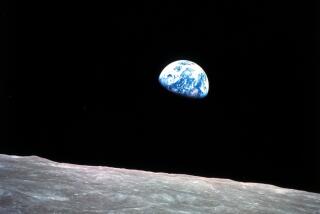Review: ‘Armstrong’ examines the man behind the moon landing
- Share via
With the 50th anniversary of man’s first steps on the moon just days away, movies dealing with the event have been thick on the land for awhile. But even if you think you’ve seen enough, “Armstrong” is worth your time.
It’s not that the other theatrical films, which include last year’s Ryan Gosling-starring “First Man” and the more recent, visually arresting documentary “Apollo 11,” have been lacking in quality.
Rather it’s that this latest doc, directed by David Fairhead, does something those others don’t. It enables audiences to get a sense of what the real Neil Armstrong was like, to get to know, as much as it’s possible, this often unknowable individual.
To do so the filmmakers have gotten the cooperation of the people who were closest to him: his sister June, his sons Mark and Rick, and his first wife, Janet, who died last year at age 84.
Not that Armstrong himself was verbally demonstrative, far from it. “He was not the most verbose person you ever met,” says son Mark, with Janet pithily adding, thinking back, “he didn’t like to talk about much and he never did talk about much.”
So even though the filmmakers have enlisted Harrison Ford, something of a pilot himself, to provide a voice-over reading of Armstrong’s words, it’s the thoughts of others as well as his actions that reveal the man most.
Often looking both ordinary and uncomfortable in interviews, Armstrong seemed to absorb his four-square, work hard and keep your nose clean character from his surroundings growing up in tiny Wapakoneta, Ohio.
In fact, his happiest and most animated moment in “Armstrong” is when he returns to his birthplace to be honored after his success on the moon. “You are my people,” he says, beaming, “and I’m proud to be one of you.”
Starting as a child delighted to get a 20-cent model airplane, Armstrong always had flying on his mind, to the point of getting his pilot’s license before he got his driver’s license.
One of the things that set Armstrong apart as a pilot even as early as his stint flying in the Korean War was an almost preternatural unflappability, a coolness under pressure that became legendary.
Shot down in the war and forced to parachute out of his jet, Armstrong used what his superiors called “exceptional skill and decision making” in maneuvering out of danger while floating in the air.
After a postwar graduation from Purdue, Armstrong naturally gravitated to Edwards Air Force Base in the California deserts, where all the newest planes were tested and where his aeronautical engineering degree gave him an advantage.
“If I saw a watch, I wanted to know what time it was,” explains Frank Borman, one of several astronauts interviewed. “Neil wanted to know how it worked.”
The death of his young daughter gave Armstrong an impetus for change, and in 1962 he joined NASA’s astronaut program in Houston, one of only two civilian pilots accepted.
In 1966, in an incident effectively dramatized in “First Man,” Armstrong and David Scott were in a Gemini 8 spacecraft that began tumbling end over end so rapidly that pilot blackout and death was a distinct possibility.
Armstrong’s quick thinking kept that from happening. Scott, interviewed here, is still amazed that Armstrong could not only figure out what happened but could maneuver his body to get to the correct switch under those hellish conditions.
Armstrong is best known as the first man to set foot on the moon, but Chris Kraft, a key NASA official, says he was instrumental in selecting Armstrong over Buzz Aldrin (who is not interviewed) because of personal qualities that would make him better able to cope with the post-landing madness.
And, in truth, the celebrity Armstrong faced on his return dwarfed everyone’s expectations and was a factor in his eventual divorce. They’d been living separate lives for years, Janet Armstrong says, adding, “I was pretty low on his priority list.”
The emphasis of “Armstrong” is to demonstrate that while its subject was not superhuman, he did have exactly the gifts and character the task demanded. Not only does the Apollo 11 moon mission feel, 50 years after the fact, like something of a one-off, its central figure does as well.
------------
‘Armstrong’
Not rated
Running time: 1 hour, 40 minutes
Playing: Arena Cinelounge, Hollywood
More to Read
Only good movies
Get the Indie Focus newsletter, Mark Olsen's weekly guide to the world of cinema.
You may occasionally receive promotional content from the Los Angeles Times.











